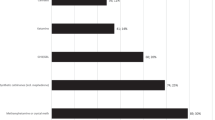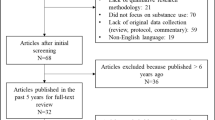Abstract
Purpose of Review
In this scoping review, we examined sex as a substitute addiction for other substance or behavioral addictions, with a particular emphasis on how it has been defined, has presented clinically, the samples and contexts studied, and the methods used. Various types of sexual behaviors were included (e.g., voyeurism, and pornography use).
Recent Findings
Overall, 18 peer-reviewed articles, published between 1954 and 2023, were retained. Across studies, and pathways to recovery, the most salient lines of inquiry appear to concern sex as a substitute among substance use service users, 13th stepping/sexual activity among recovery support group attendees, multi-addictions, pornography as a replacement for substance use (including during the COVID-19 pandemic), and hypersexual disorder in the context of bariatric surgery.
Summary
Further focused research is needed, including the use of qualitative and mixed methods studies, larger representative samples, and more robust study designs.

Similar content being viewed by others
Data Availability
The authors confirm that the data supporting the findings of this study are available within the article and its supplementary materials.
References
Papers of particular interest, published recently, have been highlighted as: •• Of major importance
Sussman SY. Substance and behavioral addictions: concepts, causes, and cures. Cambridge: Cambridge University Press; 2017.
•• Sussman S, Sinclair DL, Clifasefi S, Collins S. “Similarities and differences between harm reduction and substitute addiction-- implications for the health professions.,” Eval. Health Prof., (under review). The first study to address the potential overlap between harm reduction and substitute addiction and consider its implications for recovery.
Sussman S, Black DS. Substitute addiction: a concern for researchers and practitioners. J Drug Educ. 2008;38(2):167–80. https://doi.org/10.2190/DE.38.2.e.
Castro-Calvo J, Ballester-Arnal R, Potenza MN, King DL, Billieux J. Does ‘forced abstinence’ from gaming lead to pornography use? Insight from the April 2018 crash of Fortnite’s servers. J Behav Addict. 2018;7(3):501–2. https://doi.org/10.1556/2006.7.2018.78.
Sinclair DL, Vanderplasschen W, Savahl S, Florence M, Best D, Sussman S. Substitute addictions in the context of the COVID-19 pandemic. J Behav Addict. 2021;9(4):1098–102. https://doi.org/10.1556/2006.2020.00091.
Horvath T. Substitute addictions. Smart Recovery News Views. 2006;12(2):1–12.
Shapira B, Berkovitz R, Rosca P, Lev-Ran S, Kaptsan A, Neumark Y. Why switch? - motivations for self-substitution of illegal drugs. Subst Use Misuse. 2021;56(5):627–38. https://doi.org/10.1080/10826084.2021.1887246.
Sinclair DL, et al. Substitute behaviors following residential substance use treatment in the Western Cape, South Africa. Int J Environ Res Public Health. 2021;18(23):12815. https://doi.org/10.3390/ijerph182312815.
Selby S. A look at cross-addiction. Minnesota, USA: Hazelden Publishing; 1993.
White W, Kurtz E. The varieties of recovery experience: a primer for addiction treatment professionals and recovery advocates. Int J Self Help Self Care. 2005;3(1–2):21–61. https://doi.org/10.2190/911R-MTQ5-VJ1H-75CU.
•• Sinclair DL, Sussman S, Savahl S, Florence M, Adams S, Vanderplasschen W. Substitute addictions in persons with substance use disorders: a scoping review. Subst Use Misuse. 2021;56(5):683–96. https://doi.org/10.1080/10826084.2021.1892136. The first comprehensive review to map the literature on substitute substances or behaviors for substance use disorders. It summarizes related definitions, types of substitutes, clinical presentations, samples recruited, methods used, etiology (explanatory theories), and prevalence. The authors also offer a novel definition of substitute addictions.
Freimuth M, et al. Expanding the scope of dual diagnosis and co-addictions: behavioral addictions. J Groups Addict Recovery. 2008;3(3–4):137–60. https://doi.org/10.1080/15560350802424944.
Carnes P, Schneider JP. Recognition and management of addictive sexual disorders: guide for the primary care clinician. Lippincotts Prim Care Pract. 2000;4(3):302–18.
Tadpatrikar A, Sharma MK. Pornography as a replacement for substance use: an emerging approach to understand addiction mechanism. Open J Psychiatry Allied Sci. 2018;9(2):173. https://doi.org/10.5958/2394-2061.2018.00036.8.
Arksey H, O’Malley L. Scoping studies: towards a methodological framework. Int J Soc Res Methodol. 2005;8(1):19–32. https://doi.org/10.1080/1364557032000119616.
Tricco AC, et al. PRISMA Extension for Scoping Reviews (PRISMA-ScR): Checklist and Explanation. Ann Intern Med. 2018;169(7):467–73. https://doi.org/10.7326/M18-0850.
Lucas PJ, Baird J, Arai L, Law C, Roberts HM. Worked examples of alternative methods for the synthesis of qualitative and quantitative research in systematic reviews. BMC Med Res Methodol. 2007;7(1):4. https://doi.org/10.1186/1471-2288-7-4.
Ali AY. Substitute addictions: ‘Catching the Animagi and throwing away the Metamorphmagi.’ Int J Emerg Ment Health Hum Resil. 2015;17(4):710–1.
Bogart CJ, Pearce CE. ‘13th-stepping:’ Why Alcoholics Anonymous is not always a safe place for women. J Addict Nurs. 2003;14(1):43–7. https://doi.org/10.1080/10884600305373.
Bonny-Noach H, Gold D. Addictive behaviors and craving during the COVID-19 pandemic of people who have recovered from substance use disorder. J Addict Dis. 2021;39(2):257–64. https://doi.org/10.1080/10550887.2020.1856298.
•• Dickhut C, et al. No addiction transfer from preoperative food addiction to other addictive behaviors during the first year after bariatric surgery. Eur Eat Disord Rev. 2021;29(6):924–36. https://doi.org/10.1002/erv.2857. A longitudinal study on the substitution of food addiction with other addictive behaviors with assessments before treatment and at 6- and 12-month follow-up.
KonkolÿThege B, Hodgins DC, Wild TC. Co-occurring substance-related and behavioral addiction problems: a person-centered, lay epidemiology approach. J Behav Addict. 2016;5(4):614–22. https://doi.org/10.1556/2006.5.2016.079.
Mansky PA. Issues in the recovery of physicians from addictive illnesses. Psychiatr Q. 1999;70(2):107–22. https://doi.org/10.1023/A:1022197218945.
Müller A, et al. Food addiction and other addictive behaviours in bariatric surgery candidates. Eur Eat Disord Rev. 2018;26(6):585–96. https://doi.org/10.1002/erv.2629.
Savitt RA. Extramural psychoanalytic treatment of a case of narcotic addiction. J Am Psychoanal Assoc. 1954;2(3):494–502. https://doi.org/10.1177/000306515400200309.
Sinclair DL, Sussman S, Vantomme L, Florence M, Savahl S, Vanderplasschen W. “Service providers’ perceptions of substitute addictions in the Western Cape, South Africa,” J. Drug Issues 2023;002204262311595. https://doi.org/10.1177/00220426231159550.
Sinclair DL, Sussman S, Savahl S, Florence M, Vanderplasschen W. Narcotics Anonymous attendees’ perceptions and experiences of substitute behaviors in the Western Cape, South Africa. Subst Abuse Treat Prev Policy. 2023;18(1):40. https://doi.org/10.1186/s13011-023-00552-z.
Sinclair DL, Sussman S, Savahl S, Florence M, Vanderplasschen W. Recovery and substitute addictions: a multi-method study in the Western Cape, South Africa. Afr Focus. 2022;35(2):421–36. https://doi.org/10.1163/2031356X-35020011.
Sussman S. The relations of cigarette smoking with risky sexual behavior among teens. Sex Addict Compulsivity. 2005;12(2–3):181–99. https://doi.org/10.1080/10720160500203732.
Young EB. The role of incest issues in relapse. J Psychoactive Drugs. 1990;22(2):249–58. https://doi.org/10.1080/02791072.1990.10472547.
Zarate D, Ball M, Montag C, Prokofieva M, Stavropoulos V. Unravelling the web of addictions: a network analysis approach. Addict Behav Rep. 2022;15: 100406. https://doi.org/10.1016/j.abrep.2022.100406.
Sussman S, Arpawong TE, Sun P, Tsai J, Rohrbach LA, Spruijt-Metz D. Prevalence and co-occurrence of addictive behaviors among former alternative high school youth. J Behav Addict. 2014;3(1):33–40. https://doi.org/10.1556/JBA.3.2014.005.
Vilsaint CL, Kelly JF, Bergman BG, Groshkova T, Best D, White W. Development and validation of a Brief Assessment of Recovery Capital (BARC-10) for alcohol and drug use disorder. Drug Alcohol Depend. 2017;177:71–6. https://doi.org/10.1016/j.drugalcdep.2017.03.022.
Cummins RA, Lau AL. “Personal wellbeing index–school children.” Deakin University, 2005.
Reid RC. Personal perspectives on hypersexual disorder. Sex Addict Compulsivity. 2013;20(1–2):4–18. https://doi.org/10.1080/10720162.2013.772876.
Author information
Authors and Affiliations
Contributions
D.S. and S.S. wrote the main manuscript text and D.S. prepared the tables and figure. All authors reviewed the manuscript.
Corresponding author
Ethics declarations
Conflict of Interest
The authors declare no conflict of interest.
Human and Animal Rights and Informed Consent
This article does not contain any studies with human or animal subjects performed by any of the authors.
Additional information
Publisher's Note
Springer Nature remains neutral with regard to jurisdictional claims in published maps and institutional affiliations.
Supplementary Information
Below is the link to the electronic supplementary material.
Rights and permissions
Springer Nature or its licensor (e.g. a society or other partner) holds exclusive rights to this article under a publishing agreement with the author(s) or other rightsholder(s); author self-archiving of the accepted manuscript version of this article is solely governed by the terms of such publishing agreement and applicable law.
About this article
Cite this article
Sinclair, D.L., Sussman, S. Sex as a Substitute Addictive Behavior: a Scoping Review. Curr Sex Health Rep 16, 1–11 (2024). https://doi.org/10.1007/s11930-023-00378-7
Accepted:
Published:
Issue Date:
DOI: https://doi.org/10.1007/s11930-023-00378-7




